Related Research Articles

YuYu Hakusho is a Japanese manga series written and illustrated by Yoshihiro Togashi. The series tells the story of Yusuke Urameshi, a teenage delinquent who is struck and killed by a car while attempting to save a child's life. After a number of tests presented to him by Koenma, the son of the ruler of the afterlife Underworld, Yusuke is revived and appointed the title of "Underworld Detective". With this title he must investigate various cases involving demons and apparitions in the Human World, with the manga gradually becoming more focused on martial arts battles and tournaments as it progresses. Togashi began creating YuYu Hakusho around November 1990, basing the series on his interests in the occult and horror films and an influence of Buddhist mythology.
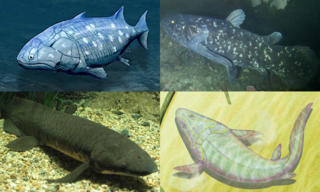
Sarcopterygii — sometimes considered synonymous with Crossopterygii — is a taxon of the bony fishes known as the lobe-finned fishes. The group Tetrapoda, a mostly terrestrial superclass including amphibians, sauropsids and synapsids, evolved from certain sarcopterygians; under a cladistic view, tetrapods are themselves considered a subgroup within Sarcopterygii.
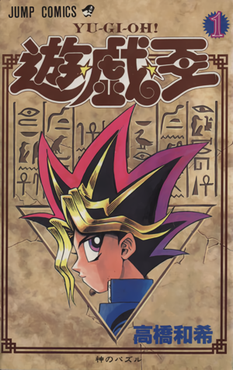
Yu-Gi-Oh! is a Japanese manga series written and illustrated by Kazuki Takahashi. It was serialized in Shueisha's Weekly Shōnen Jump magazine between September 1996 and March 2004. The plot follows the story of a boy named Yugi Mutou, who solves the ancient Millennium Puzzle. Yugi awakens a gambling alter-ego or spirit within his body that solves his conflicts using various games.

Caridina is a genus of freshwater atyid shrimp. They are widely found in tropical or subtropical water in Asia, Oceania and Africa. They are filter-feeders and omnivorous scavengers. They range from 0.9–9.8 mm to 1.2–7.4 mm in carapace length.

Pantherinae is a subfamily within the family Felidae; it was named and first described by Reginald Innes Pocock in 1917 as only including the Panthera species. The Pantherinae genetically diverged from a common ancestor between 9.32 to 4.47 million years ago and 10.67 to 3.76 million years ago.
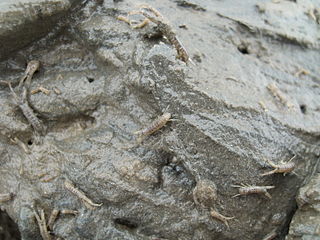
Corophiidae is a family of amphipods, containing the following genera:

The Cerophytidae are a family of beetles belonging to Elateroidea. Larvae are associated with rotting wood, on which they are presumed to feed. The family contains over 20 species in five genera, primarily distributed in the New World, but also in Eurasia and Africa. 17 fossil species in 7 genera are known extending to the Early Jurassic. Like some other elateroids, the adults are capable of clicking.

Szechenyi's monal-partridge, also known as buff-throated partridge or buff-throated monal-partridge, is a member of the family Phasianidae in the order Galliformes. They are endemic to western China.

The Indian giant flying squirrel, also called the large brown flying squirrel or the common giant flying squirrel, is a species of rodent in the family Sciuridae. It is capable of gliding flight using a skin membrane stretched between front and hind legs. It is found in mainland Southeast and South Asia, and southern and central China.

The Ministry of Transportation and Communications is a cabinet-level governmental body of the Republic of China (Taiwan), in charge of all policy and regulation of transportation and communications networks and administration of all transportation and communications operations and enterprises in Taiwan.
Helcionelloida is an extinct group of ancient molluscs. These are the oldest known conchiferan molluscs, that is, they had a mineralised shell. Some members of this class were mistaken for Monoplacophorans. The class was erected by Peel in 1991.
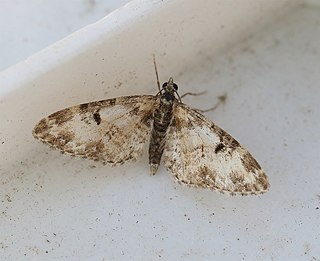
Eupithecia irriguata, the marbled pug, is a moth of the family Geometridae. The species can be found in Europe and North Africa.
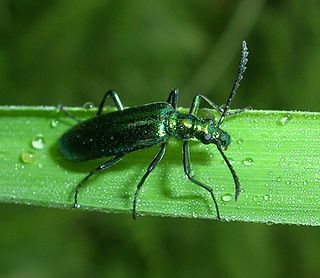
Prionoceridae is a small family of beetles, in the suborder Polyphaga. They form a group within the cleroid beetles and were formerly treated as a subfamily (Prionocerinae) within the family Melyridae. Very little is known of their life history but most species are pollen feeders as adults and occur in large numbers during spring or the host flowering season. Larvae are predatory or feed on decomposing wood.
The pygmy bamboo bat is a species of vesper bat in the family Vespertilionidae. It is found in Southwest China and was discovered in 2007. The species is around 4 cm (1.6 in) long and weighs between 2.6 and 3.5 g.
Nitrospirota is a phylum of bacteria. It includes multiple genera, such as Nitrospira, the largest. The first member of this phylum, Nitrospira marina, was discovered in 1985. The second member, Nitrospira moscoviensis, was discovered in 1995.

Horaiclavidae is a family of predatory sea snails, marine gastropod mollusks in the superfamily Conoidea.

Sinocorophium is a genus of amphipod crustaceans.
Oryctocephalus indicus is a species of corynexochid trilobite from the Cambrian. Its first appearance is proposed for the lower boundary of the Wuliuan, which corresponds to the beginning of the Miaolingian. The species was first described by the British paleontologist Frederick Richard Cowper Reed in 1910 as Zacanthoides indicus. It was transferred to the genus Oryctocephalus by the American paleontologist Charles Elmer Resser in 1938.

Sinocorophium hangangense is a species of gammaridean amphipod found mainly in Korea. The species was found in the lower reaches of Han River in Gyeonggi-do, Korea. The shape of the first and the third uropods, the posterior appendages, alongside the relatively large size of the body distinguishes the Sinocorophium hangangense from other related species.
Calcarisporiellaceae is a family of fungi within the subkingdom Mucoromycota. It is the only family in the order Calcarisporiellales, class Calcarisporiellomycetes, subphylum Calcarisporiellomycotina and phylum Calcarisporiellomycota. It contains two known genera, Calcarisporiella and Echinochlamydosporium. The two genera each have one species.
References
- ↑ Jim Lowry (2011). "Sinocorophium heteroceratum (Yu, 1938)". WoRMS. World Register of Marine Species . Retrieved November 27, 2011.
- ↑ "Corophium heteroceratum Yu, 1938". California Academy of Sciences. 2002.